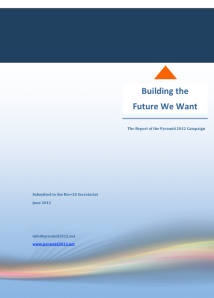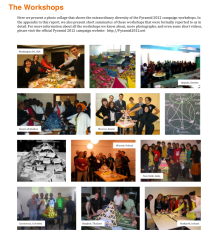Welcome to Pyramid 2012!
On 18 June 2012, we released the final report of the Pyramid 2012 campaign. You can download that report here (14 pages, in .pdf format), as well as the accompanying press release. (The text of the Press Release, long version, also appears below.)
Download the press release (2-page format) >>
Download the press release (1-page format) >>
Release date: 18 June 2012
Contact: AtKisson Group
“Global Workshop” Sows Seeds of Action for Sustainability Around the World
The AtKisson Group released today a new report detailing the results of a “global workshop campaign” designed to raise awareness about sustainability thinking, collaboration, and action. The voluntary initiative, called “Pyramid 2012,” was timed to support the United Nations “Rio+20” global summit on sustainable development. More than one thousand people in over 20 countries participated in the Pyramid 2012 campaign during February and March 2012, generating dozens of policy proposals, recommendations, and even new commitments to pursue local projects.
Pyramid 2012 engaged at least 65 groups in 20 countries — including, for example, city planners in Germany, small farmers in Colombia, water specialists in southern Africa, graduate students in Iceland, and many others — in one-day workshops based on the AtKisson “Building the Pyramid” group learning and planning tool. A simplified version of this tool, “Pyramid Lite,” was made freely available on the Internet. Volunteers who signed up to organize a workshop in their area using Pyramid Lite were asked to report on their results.
The Pyramid 2012 global report, Building the Future We Want, summarizes these results, as well as the key messages that emerged from the workshops. Cristina Apetrei, the campaign’s coordinator, noted that “there seems to be a shared understanding around the world that many actions, taken at the local level, can add up to the global transformation we call sustainable development. People do want to get active, and they really can make a difference.”
A Pyramid workshop guides groups through a five-step process of thinking and discussion, focused on a “Central Challenge” related to sustainability, whether global or local. Participants explore what the trends are, how they link together, and try to identify the root causes of the problems they have identified. Then they brainstorm creative new solutions, and strategize how to get those solutions accepted and implemented. The process helps them build consensus, which can then lead to a commitment to act.
“As consultants, we’ve done successful Pyramid workshops for senior government officials, university faculty, inter-governmental programs, and businesses, as well as many student groups, for over ten years” said campaign initiator Alan AtKisson, president of AtKisson Group. “With Pyramid 2012, we wanted to put a version of this tool freely into the hands of volunteers, and bring some more positive attention to the practice of sustainable development. Everybody has been focusing on how difficult the negotiations around sustainability issues have been at the global level. We wanted to show what was possible at the local level.”
Specific results from the 65 documented Pyramid 2012 workshops included:
- A campus clean-up and waste reduction program for a college in Zimbabwe
- Plans to create new bicycle parking areas for a university in Gdansk, Poland
- An initiative to raise awareness about the plight of sea turtles in Trinidad and Tobago
- An action program supporting peasant farmers in Colombia to manage scarce water resources
- A new technical and process solution for reducing detergent run-off from an industrial plant in Germany
… and many others. Campaign coordinators were so pleased by the results that they immediately launched a process of consultation to consider whether, and how, to scale it up. “The enthusiastic reactions we received, as well as the quality of the workshop outcomes, exceeded our modest expectations by a lot, especially considering that we had one part-time coordinator and no marketing or communication budget,” said Cristina Apetrei. “We cannot but wonder now, what would happen if we got the resources to do a program like this at a much larger scale?”
Alan AtKisson noted: “Pyramid 2012 actually fulfills a dream I had fifteen years ago. I fell in love with the idea of groups of people, all over the world, building something interesting and creative together — something that reflected their insights and aspirations for sustainable development. With the help of my colleagues, that dream turned into the Pyramid workshop.”
But AtKisson’s dream of a large global event focused on Pyramid went dormant for more than a decade. “Then last year Tom Mclean, a teacher at the International School of Manila, wrote and invited me to keynote an international conference of students” (called Global Issues Network, an annual event sponsored by the East Asian Regional Council of Schools, EARCOS). “Tom described how 400 high school students were going to do 20 parallel Pyramid workshops, on different sustainability issues, all at the same time. Of course, I sent him an enthusiastic yes … and then I thought, why not expand this? Why not multiply it, by inviting groups of all kinds, in many other places, to join in … and build their own Pyramids?”
The resulting Pyramid 2012 campaign officially kicked off at “GIN Manila,” in the Philippines, on 17 February 2012. Those 20 parallel student workshops used Pyramid to explore solutions to a wide range of global problems, including deforestation, loss of habitat, climate change, water scarcity, and digital divide. Meanwhile, other groups — invited to participate through a wide variety of email lists and websites — downloaded the “Pyramid Lite” manual and began convening around the world. As they completed their workshops, they sent photos and reports. “Some of these Pyramids turned out to be beautiful, too,” said AtKisson
He was especially impressed with a group of architecture students at a university in Bangladesh. “Their workshop produced recommendations for improving urban mobility in Dhaka. That was great, but their Pyramid was amazing. It looked like it was made of illuminated stained glass.”
The 14-page Pyramid 2012 report is available for download at the campaign website, http://Pyramid2012.net. There, readers can also find detailed reports from the workshop groups and links to photos as well as videos from around the world. If you want to write about the Pyramid 2012 campaign and wish to interview Alan AtKisson or Cristina Apetrei, please contact AtKisson Group associate Dana Kapitulčinová (based in Copenhagen): Dana.Kapitulcinova@AtKisson.com.


It was sad that our pyramid not include on the report, but we build pyramid not just for reporting, we starting late, we strat at May, until now we’ve been doing 6 pyramid, we’ll still doing it till December. Hope could make it 25 at the end of this year…
Posted by aulia wijiasih | 19 June 2012, 15:53That’s great, Aulia! Send us information and photos, we can post something here at least!
Posted by Editor | 8 August 2012, 22:04